Prayer and Devotion Ministries
For where two or three are gathered together in my name, there am I in the midst of them. Matthew 18:20
St. Therese Parish, known for its deep spirituality, offers many opportunities to come together as a community to pray. Not only do we offer a 24-hour-a-day, seven-days-a-week Perpetual Eucharistic Adoration Chapel, but we also offer on a weekly basis: a Rosary Prayer Group, which prays the Rosary after the weekday 8:00 a.m. Mass; a weekly Exposition & Benediction service on Thursday evenings; a St. Joseph Devotion on Wednesday evenings; the Prayer Intercessors for Priests Group, which meets every Thursday after the Benediction service to pray for priests; an active Legion of Mary, which meets on Monday evenings; and a monthly First Friday Mass and All-Night Prayer Vigil.
We also have various devotions offered on an annual basis, including the Stations of the Cross every Friday in Lent, and the Divine Mercy Devotion on the Sunday after Easter.
Please take advantage of these opportunities to grow in your spirituality and strengthen your relationship with God.

Prayer and Devotion Ministries
"Can you not watch one hour with Me?" -Matthew 26:44
"Once you understand the Eucharist, you can never leave the Church. Not because the Church won't let you, but because your HEART won't let you!"
WELCOME! The Presentation Chapel of Perpetual Eucharistic Adoration of St. Therese Church continues the centuries-old practice of adoration of the Blessed Sacrament twenty-four hours per day, seven days per week (it began here in January of 1988).
WHAT IS PERPETUAL EUCHARISTIC ADORATION? Perpetual Eucharistic Adoration is the adoration of Jesus Christ, truly present in the Holy Eucharist. The Eucharist is displayed in a special holder called a "monstrance," so that people can come to pray and worship Jesus continually throughout the day and night. Archbishop Fulton Sheen said that the first Holy Hour was in the Garden of Olives when Jesus asked the apostles to pray with Him. He loves us without limit, and offers Himself to us in the Holy Sacrament of the Eucharist. Can we not give Jesus a few minutes of love and adoration in return?
LOCATION OF THE CHAPEL: Enter on the parking lot side of the church. Just follow the sidewalk between the church and the white iron fence until you get to the double glass doors. You will see a large picture of Jesus' Divine Mercy.
In December of 2012, the Carmelite Friars moved out of the former rectory (now called "The Parish Offices")—freeing up a lot of space for other purposes. After much discernment, the pastor at the time, Fr. Philip Sullivan, decided to move the Chapel to the former rectory and to restore the former Adoration Chapel back to a Baptistry, as originally designed by the architect. This move took place on February 2, 2015. The Baptistry was restored in 2019.
Because it was moved on the Feast of the Presentation, the chapel has been named the “The Presentation Chapel,” and is dedicated to the Loving Memory of Fr. Jerome Lantry, OCD (there is a large oil painting--by Belita William--of him in the foyer of the new chapel). The space where the chapel was previously located in the back of the church has been restored to the architect's intended purpose as a Baptistry (which is dedicated to the Loving Memory of Fr. William Fenton).
ELECTRONIC KEYS: There had been security issues with the chapel in its previous location. To prevent these problems, Adorers using the chapel between 5:00 pm and 6:00 am will need to register for their own electronic keys (for a small deposit of $20 each). All registered users need to refrain from lending their keys and from allowing unknown persons to follow them into the chapel.
LAST PERSON IN THE CHAPEL?: There is a photochromic glass in front of the monstrance. If at the time you are leaving the chapel, there is no one else in it, please TURN OFF THE LIGHT (the switch is to the left of the door as you exit) on your way out. This will cause the glass in front of the monstrance to turn dark so that Our Lord will not be exposed in an empty room. Likewise, if you are the first to re-enter, TURN THE LIGHT BACK ON, and the glass will clear.
MAKE A COMMITMENT: If you haven’t already done so, please commit to coming to the Chapel at the same hour and day each week.
PRAY FOR VOCATIONS: Ever since our chapel opened in 1988, one of its primary purposes is to pray for vocations to the consecrated life, in particular to our own Archdiocese and Carmelite Community.
GUIDELINES: Using the chapel requires following the guidelines listed below:
ADORATION CHAPEL GUIDELINES
ELECTRONIC KEY CARDS: If you have been issued an electronic key card for attending during the hours of 5:00 p.m. and 6:00 a.m., please observe the following:
- Do not lend or give the key card to anyone. You will be responsible for any misuse or damages to the chapel.
- Do not allow anyone unknown to you to follow you into the chapel. Inform anyone who attempts to follow you into the chapel that he or she must register in the parish offices in order to enter after hours.
- Do not put your name on the key card or mark it in any way. You may attach it to you rkey ring or a lanyard or put in your billfold or wallet. If in your billfold or wallet, you do not have to remove it from there. Simply hold the billfold or wallet near the key detector on the wall to the right of the door and you will hear it buzz (then just push the door open; make sure it closes firmly behind you!). You will find yourself in the foyer. The chapel itself is behind the frosted door on the left side.
SIGN IN / OUT FORM: If you are a COMMITTED ADORER, please arrive five (5) minutes early to show courtesy to the person(s) adoring before you who may need to leave on time.
- Each time you enter the chapel, you must sign in upon arrival (the Register is located in the vestibule of the chapel) and sign out when you leave. This is how we know Our Lord is being adored.
- Check the sign-in binder before you leave to be certain the next two committed adorers are in the chapel.
- If the adorers after your hour do not show up and you choose to be the substitute for the next hour, sign your name on the sign-in sheet and write “substitute” after your name. If you do need to leave before the next adorer arrives, please turn OFF the lights. This will cause the protective glass in front of the Monstrance to darken so that Our Lord is not left exposed in an empty room.
ADORATION ETIQUETTE
- Reverence the Blessed Sacrament upon entering. You are standing on Holy Ground!
- Please respect the presence of our Lord by turning off your cell phone and refraining from conversing with others.
- If you have children, keep them occupied with books or some quiet activity. Should your child get anxious, please take him/her out so as not to disturb the other adorers.
- CHILDREN MUST BE ACCOMPANIED BY AN ADULT TO THE RESTROOMS AND ARE NOT ALLOWED TO WANDER, IN ACCORDANCE WITH THE “SAFEGUARD THE CHILDREN” POLICY.
- Please do not bring any food or beverages into the Chapel.
- Please remember to take off your hats; dress appropriately; don’t chew gum; and observe the same etiquette as if you were at Mass or in a courtroom.
- Please do not move any of the furniture.
- Please do not touch the altar and do not place anything on it.
- THE GLASS WINDOW PROTECTING OUR LORD SHOULD NOT BE TOUCHED!!!
Spiritual reading material provided for adorers must remain on the bookshelf. Do not leave any reading material that has not been approved by the Carmelite Fathers or the Religious Education Staff.
Please observe silence in the Adoration Chapel. Rosaries, Chaplets, or any other devotional prayers or songs should be prayed in silence. - There is to be NO SLEEPING in the Adoration Chapel! Please make sure you are well-rested if you are committed to adore late at night.
GETTING A SUBSTITUTE : You are the Guardian of the Eucharist during your hour. It is your responsibility to find someone to cover your hour when you cannot be there. If for any reason you are unable to attend your committed hour, please try your best to find a replacement. If you are a committed adorer who comes between the hours of 5:00 p.m. and 6:00 a.m., the substitute you schedule to cover your time slot must be another committed adorer with his or her own key. Please get to know those assigned before and after your committed hour and exchange contact information. They may be able to cover your hour.
EMERGENCY CONTACT: The Chapel has security cameras (outside the door, in the foyer, and in the chapel itself). If you feel a need to call the police, the phone number for the Alhambra Police Department is (626) 570-5168.
COMMITTED ADORERS: Although you are welcomed to pray there any time, we would appreciate if you would sign up to come to adore our Lord at for the early morning hours between Midnight and 5:00 a.m. (at that same hour each week). Call the office at (626) 282-2744 to do so.
ADORATION QUOTES
Our Lord (to Sr. Margaret Mary Alacoque during an apparition on the octave of the Feast of the Blessed Sacrament on June 16, 1675): “Behold this Heart which has so loved men that it has spared nothing, even to exhausting and consuming itself, in order to testify its love. In return, I receive from the greater part only ingratitude, by their irreverence and sacrilege, and by the coldness and contempt they have for Me in this Sacrament of love. What is most painful to Me," added the Savior, in a tone that went to the Sister's heart, "is that they are hearts consecrated to Me”.
St. Pope John Paul II: "I hope that perpetual adoration, with permanent exposition of the Blessed Sacrament, will continue into the future." (International Eucharistic Congress in Seville, Spain, June, 1993)
St. Pope John Paul II: "Public and private devotion to the Holy Eucharist outside Mass is highly recommended: for the presence of Christ, who is adored by the faithful in the Sacrament, derives from the sacrifice and is directed towards sacramental and spiritual communion." (Inaestimabile Donum, #20, 1980)
St. Pope John Paul II: "The Church and the world have great need of Eucharistic adoration. Jesus waits for us in this Sacrament of Love. Let us be generous with our time in going to meet Him in adoration and contemplation full of faith. And let us be ready to make reparation for the great faults and crimes of the world. May our adoration never cease" (Dominicae Cenae: Letter to Priests, Holy Thursday, 1980).
St. Pope John Paul II: "Closeness to the Eucharistic Christ in silence and contemplation does not distance us from our contemporaries but, on the contrary, makes us open to human joy and distress, broadening our hearts on a global scale. Through adoration the Christian mysteriously contributes to the radical transformation of the world and to the sowing of the gospel. Anyone who prays to the Eucharistic Savior draws the whole world with him and raises it to God." (Letter to the Bishop of Liege, Reported in L'Osserv. Romano, 1996)
Jose Guadalupe Trevino: “Did you ever consider well, dear Christian soul, that, when the Sacred Host is publicly exposed, Jesus is not on His Eucharistic throne to receive the adorations of the angels and to enjoy the company of the blessed? These He finds in heaven. But He is on His Eucharistic throne to receive your adorations, to listen to your confidences, and to console and alleviate your sorrows and trials.”
Blessed Dina Belanger: “I am making my retreat with the Eucharistic Heart. I am on fire, burning with the desire to love God and to bring others to love him. 'Our Lady of the Eucharistic Heart, I beg you to give Jesus to soul’”
St. Gertrude: “I understand that, each time we contemplate with desire and devotion the Host in which is hidden Christ's Eucharistic Body, we increase our merits in heaven and secure special joys to be ours later in the beatific vision of God.”
St. Anselm: “I adore and venerate you as much as ever I can, though my love is so cold, my devotion so poor. Thank you for the good gift of this your holy Body and Blood, which I desire to receive.”
St. Justin Martyr (2nd Century): "This food we call the Eucharist, of which no one is allowed to partake except one who believes that the things we teach are true, and has received the washing for forgiveness of sins and for rebirth, and who lives as Christ handed down to us. For we do not receive these things as common bread or common drink; but as Jesus Christ our Savior being incarnate by God's Word took flesh and blood for our salvation, so also we have been taught that the food consecrated by the Word of prayer which comes from him, from which our flesh and blood are nourished by transformation, is the flesh and blood of that incarnate Jesus."
St. Augustine: "God in his omnipotence could not give more... in His wisdom He knew not how to give more... in His riches He had not more to give, than the Eucharist."
Pope Benedict XV: "In the Eucharist, this divine Heart governs us and loves us by living and abiding with us, so that we may live and abide in Him, because in this Sacrament... He offers and gives Himself to us as victim, companion, viaticum, and the pledge of future glory."
St. Pope John Paul II: “In the Eucharist, Christ is truly present and alive, working through His Spirit; yet, as Saint Thomas said so well, ‘what you neither see nor grasp, faith confirms for you, leaving nature far behind; a sign it is that now appears, hiding in mystery realities sublime’. He is echoed by the philosopher Pascal: ‘Just as Jesus Christ went unrecognized among men, so does His truth appear without external difference among common modes of thought. So too does the Eucharist remain among common bread’.” (Encyclical: "Faith and Reason")
Archbishop Fulton J. Sheen's "This is the Mass": "By a beautiful paradox of Divine love, God makes His Cross the very means of our salvation and our life. We have slain Him; we have nailed Him there and crucified Him; but the Love in His eternal heart could not be extinguished. He willed to give us the very life we slew; to give us the very Food we destroyed; to nourish us with the very Bread we buried, and the very Blood we poured forth. He made our very crime into a happy fault; He turned a Crucifixion into a Redemption; a Consecration into a Communion; a death into Life Everlasting."
From "Worthy Is the Lamb": "Through Perpetual Eucharistic Adoration, Jesus longs to open up the floodgates of His merciful love on a troubled world. He longs to heal a broken humanity. Otherwise, He continues to weep in spirit and say: ‘O Jerusalem, Jerusalem, you slay the prophets and stone those who are sent to you!’ How often have I wanted to gather your children together as a mother bird collects her young under her wings, and you refused me! Your temple will be abandoned I say to you, you shall not see me until the time comes when you say, 'Blessed is He who comes in the name of the Lord'" (Luke 13:34-36). Fr. Michael Muller, CSSR: "That same Jesus is with us in our churches today who, at His birth was laid on straw and adored by the Magi, who was sought by the Blessed Virgin and found in the Temple, who changed water into wine, who restored sight to the blind, made deaf to hear and the dumb to speak, who died on the Cross, and then rose. Beloved Christian, you esteem Simeon happy in having been permitted to take the Infant Jesus in his arms; and were you to receive a grace like him, no doubt you would exclaim: 'Now dost Thou dismiss Thy servant in peace: because my eyes have seen Thy salvation.' "
From Nesta de Robeck's "The Life of St. Francis of Assisi": One day a rather worldly friend asked St. Francis of Assisi, "What do you do during those long hours before the Blessed Sacrament?" "My son, in return I ask you what does the poor man do at the rich man's door, the sick man in the presence of his physician, the thirsty man at a cool stream? What they do, I do before the Eucharistic God. I pray. I adore. I love."
St. Pope John XIII: The thought of the presence of God and the spirit of worship will, in all my actions, have as their immediate object Jesus, God and man, really present in the most holy Eucharist. The spirit of sacrifice, of humiliation, of scorn for self in the eyes of men, will be illuminated, supported and strengthened by the constant thought of Jesus, humiliated and despised in the Blessed Sacrament.
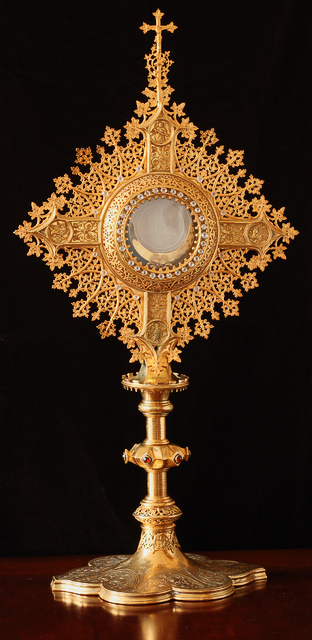
"Thou art the Christ, the Son of the Living God..."
"Tantum Ergo, Sacramentum..."
You are invited to join us in the church every Thursday evening from 7:00 to 8:00 p.m. for this beautiful service. It begins with Exposition of the Blessed Sacrament and continues with prayers and adoration. Just before 8:00 p.m., Benediction will begin, closing the service.
This following hymn, "Tantun Ergo," is short but sincere in expressing adoration of Our Lord in the Blessed Sacrament. (Following the hymn in Latin is the translation in English.)
"Tantum Ergo" is the only hymn that the Church mandates for use at Benediction of the Blessed Sacrament. It is usually sung at the beginning of the last part of Benediction; after any period of silence, and before the priest blesses the congregation with Our Lord Himself. Even today this hymn is widely known and used frequently. It is one of the most famous chants in existence.
It was written by St. Thomas Aquinas, the Angelic Doctor. He is known as the Common Doctor of the Church. His angelic purity and holiness brought him very close to God. He wrote the hymn “Pange Lingua,” (of which the Tantum Ergo is the last two stanzas) for the feast of Corpus Christi. A fellow priest and close friend attempted this task at the same time. When St. Thomas finished, he shared it with the priest, who was awe-struck at its sublimity and expression. He was so moved by its beauty that he immediately tore up his own work, which he professed was like so much garbage compared to this heavenly-inspired text.
Tantum ergo Sacramentum
Veneremur cernui:
Et antiquum documentum
Novo cedat ritui:
Praestet fides supplementum
Sensuum defectui.
Genitori, Genitoque
Laus et iubilatio,
Salus, honor, virtus quoque
Sit et benedictio:
Procedenti ab utroque
Compar sit laudatio.
Amen.
Down in adoration falling,
Lo! the sacred Host we hail,
Lo! oe'r ancient forms departing
Newer rites of grace prevail;
Faith for all defects supplying,
Where the feeble senses fail.
To the everlasting Father,
And the Son Who reigns on high
With the Holy Spirit proceeding
Forth from each eternally,
Be salvation, honor, blessing,
Might and endless majesty.
Amen.
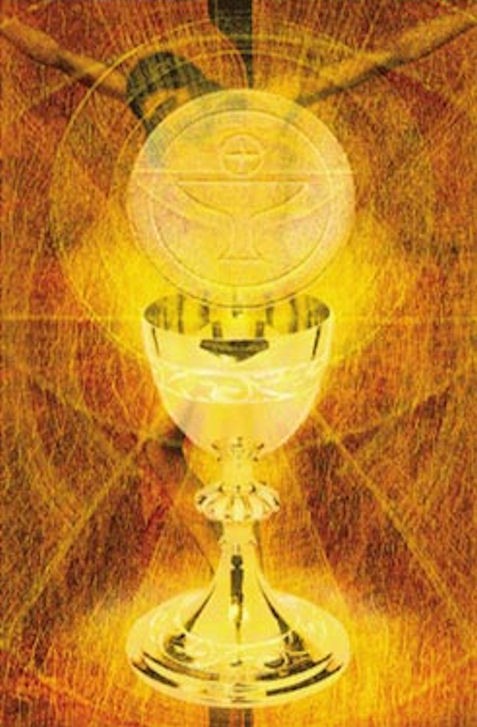
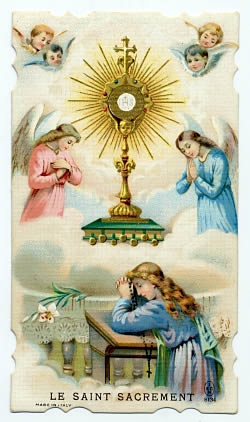
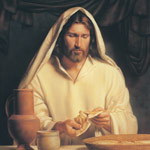
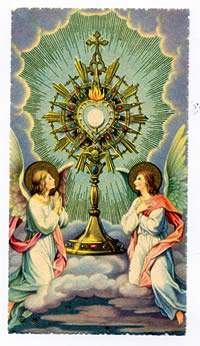
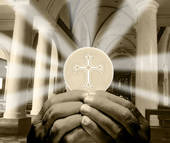
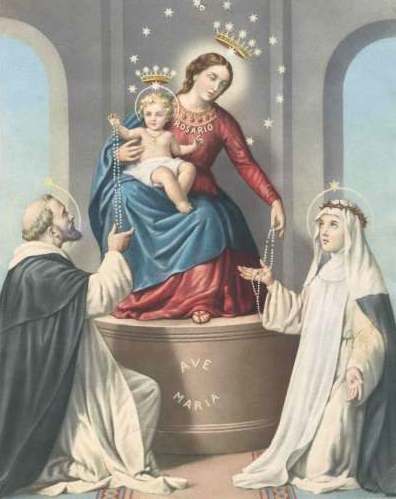
With the Rosary, we experience the depths of Christ's love. We receive abundant grace, as though from the very hands of the Mother of the Redeemer." --Pope John Paul II
The St. Therese Rosary Prayer Group prays the Rosary after the 8:00 a.m. Mass Monday through Saturday. They also have special devotions to the Sacred Heart and the Immaculate Heart of Mary. You are very welcome to join them in honoring the Blessed Virgin Mary, the Mother of God. For more information or if you would like to help lead the Rosary, please contact the coordinator, Donn Canzano, at (626) 584-5705. You may also wish to join our group, The Rosary Makers. For more information on this group, go to MINISTRIES > PEACE & JUSTICE MINISTRIES > ROSARY MAKERS.
HOW TO SAY THE ROSARY: For instructions on how to pray the Rosary and for meditations and pictures for each decade, go to the main link, PRAYERS, and then to HOLY ROSARY. From there you can click on the four sub-links to the different sets of mysteries.
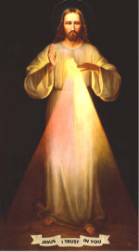
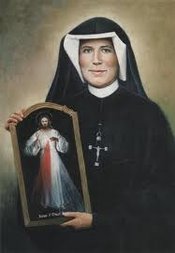
“For the sake of His sorrowful Passion, have mercy on us and on the whole world.
Divine Mercy Sunday is celebrated on the Sunday after Easter Sunday, the Octave of Easter. It is based on the devotion to the Divine Mercy that Saint Faustina Kowalska (1905-1938) reported as part of her encounter with Jesus, and is associated with special promises from Jesus and indulgences issued by the Church. It was so designated by Pope John Paul II on April 30, 2000, the same date that St. Faustina was canonized.
The normal schedule for this devotion at St. Therese Church is as follows:
3:00 to 4:00 p.m.: Exposition of the Blessed Sacrament, followed by a Holy Hour (including recitation of the Divine Mercy Chaplet)
3:00 to 5:00 p.m.: Confessions
4:45 p.m.: Benediction
5:00 p.m. Holy Mass
Following the Mass, a relic of St. Faustina will be available to be touched and venerated by everyone present.
PLENARY INDULGENCE: Our Lord promised that all who attend Mass, make their Confession, pray for the intentions of the Holy Father, and receive Holy Communion on Divine Mercy Sunday would obtain "complete forgiveness of sins and their punishment." The Vatican has extended our Lord's promise so that, if necessary, Confession can be made up to 20 days before or after Divine Mercy Sunday. Indulgences can be applied either to oneself or to the souls of the deceased (but not to another living person).
BACKGROUND OF THE DIVINE MERCY DEVOTION
In 1933, God appeared to St. Faustina (then Sister Faustina Kowalska, a young, uneducated Polish nun of the Congregation of Sisters of Our Lady of Mercy in Krakow) and gave her a striking vision of His Mercy. In obedience to her spiritual director, she wrote about these revelations in a diary of about 600 pages. In it St. Faustina tells us: "I saw a great light, with God the Father in the midst of it. Between this light and the earth I saw Jesus nailed to the Cross in such a way that God, wanting to look upon the earth, had to look through Our Lord's wounds, and I understood that God blessed the earth for the sake of Jesus."
Of another vision on Sept. 13, 1935, she writes: "I saw an Angel, the executor of God's wrath... about to strike the earth... I began to beg God earnestly for the world with words which I heard interiorly. As I prayed in this way, I saw the Angel's helplessness, and he could not carry out the just punishment...
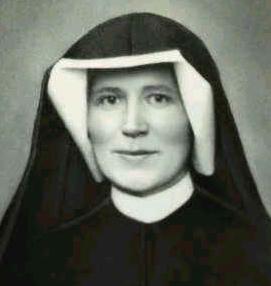
THE FEAST OF DIVINE MERCY: Jesus said “…tell the whole world about My inconceivable mercy. I desire that the Feast of Mercy be a refuge and shelter for all souls, and especially poor sinners. On that day the very depths of My tender mercy are open. I pour out a whole ocean of graces upon the souls who approach the Fount of My Mercy. On that day all the divine floodgates through which graces flow are opened. Let no soul fear to draw near to Me, even though its sins be as scarlet.... Mankind will not have peace until it turns to the Fount of My Mercy” (Diary 699).
Devotion to The Divine Mercy involves a total commitment to God as Mercy. It is a decision to trust completely in Him, to accept His mercy with thanksgiving, and to be merciful as He is merciful. The devotional practices proposed in the diary of Saint Faustina are completely in accordance with the teachings of the Church and are firmly rooted in the Gospel message of our Merciful Savior. Properly understood and implemented, they will help us grow as genuine followers of Christ. There are two scriptural verses that we should keep in mind as we involve ourselves in these devotional practices: 1. "This people honors me with their lips, but their hearts are far from me" (Is 29:13); 2. Blessed are the merciful, for they shall obtain mercy" (Mt 5:7).
THE DIVINE MERCY PROMISE: Jesus promised that, “I will grant complete pardon from sin and its punishment to the souls that will go to Confession and receive Holy Communion on the Feast of My Mercy” (Diary 1109). Our Lord also said “When you go to confession, to this fountain of My mercy, the Blood and Water which came forth from My Heart always flows down upon your soul…” and “Every time you go to confession, immerse yourself entirely in My mercy with great trust, so that I may pour the bounty of My grace upon your soul. When you approach the confessional, know this, that I Myself am waiting there for you. I am only hidden by the priest, but I Myself act in your soul. Here the misery of the soul meets the God of mercy (1602). Make your confession before Me. The person of the priest is… only a screen. Never analyze what sort of a priest that I am making use of; open your soul in confession to Me, and I will fill it with My light” (1725).
THE CHAPLET OF DIVINE MERCY: An inner voice taught St. Faustina what is now known as The Chaplet of Divine Mercy (see box). Jesus said later to Sister Faustina: "Say unceasingly this chaplet that I have taught you. Anyone who says it will receive great Mercy at the hour of death. Priests will recommend it to sinners as the last hope. Even the most hardened sinner, if he recites this Chaplet even once, will receive grace from My Infinite Mercy. I want the whole world to know My Infinite Mercy. I want to give unimaginable graces to those who trust in My Mercy..." "...When they say this Chaplet in the presence of the dying, I will stand between My Father and the dying person not as the just judge but as the Merciful Savior".
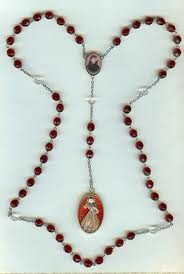
THE DIVINE MERCY IMAGE: The earliest element of the Devotion to the Divine Mercy which was revealed to St. Faustina was the Image. On February 22, 1931, Jesus appeared to her with rays radiating from His heart and said, “Paint an image according to the pattern you see, with the signature: ‘Jesus I trust in You.’ I desire that this image be venerated, first in your chapel, then throughout the world” (Diary 47). He added, “I promise that the soul that will venerate this image will not perish. I also promise victory over its enemies already here on earth, especially at the hour of death. I myself will defend it as My own glory (Diary 48). I am offering people a vessel with which they are to keep coming for graces to the fountain of mercy” (Diary 327).
“The two rays denote Blood and Water. The pale ray stands for the Water, which makes souls righteous. The red ray stands for the Blood, which is the life of souls. These two rays issued forth from the very depths of My tender mercy when My agonized heart was opened by a lance on the Cross. These rays shield souls from the wrath of My Father. Happy is the one who dwells in their shelter, for the just hand of God shall not lay hold of him" (Diary 299).

In these texts the Church's doctrine on images, justification and grace are explained. First, by itself an image is merely a painting, no matter how beautiful and expressive. Yet, it can point us to the mysteries of faith and dispose us to grasp and receive what it represents, in this case the Divine Mercy. It is thus a vessel, not the source, a reminder, not the reality. The reality is the merciful fountain of grace flowing from the pierced Heart of Christ on the Cross, and flowing out visibly to represent the visible; that is, the sacramental signs of grace, Baptism and Eucharist, standing for all the Sacraments of the Church.
The image also reminds us that salvation is not just by faith, but by works of charity also. It takes faith to see and believe in what the Image signifies, Divine Mercy poured out from Christ upon the Cross; but it takes mercy, love going beyond the strict requirements of justice, in order to draw down mercy on oneself. The Image of the pierced side of Christ pouring out blood and water reminds us that the Cross, love in action, is the price of mercy. "As I have loved you so also should you love one another" (Jn 13:34).
NOVENA BEFORE THE FEAST: In preparation for the Feast of The Divine Mercy, the Lord asked St. Faustina to make a novena of prayer from Good Friday to the following Saturday. These nine days of prayer before the Feast of Mercy are like the nine days of prayer in the upper room before the day of Pentecost (Acts 1:14). For each of the nine days, Our Lord gave St. Faustina a different intention: 1) all mankind, especially sinners; 2) the souls of priests and religious; 3) all devout and faithful souls; 4) those who do not believe in Him and those who do not yet know Him; 5) the souls of the separated brethren; 6) the meek and humble souls and the souls of little children; 7) the souls who especially venerate and glorify His mercy; 8) the souls detained in Purgatory; and 9) the souls who have become lukewarm. "I desire that during these nine days you bring souls to the fount of my mercy, that they may draw therefrom strength and refreshment and whatever grace they have need of in the hardships of life, and especially at the hour of death" (Diary 1209). You can make a novena of prayer for these intentions by praying the Chaplet of Divine Mercy.
THE THREE O'CLOCK HOUR: In His revelations to St. Faustina, Jesus asked for special, daily remembrance at 3:00 o'clock, the very hour He died for us on the Cross: "At three o'clock, implore my mercy, especially for sinners; and, if only for a brief moment, immerse yourself in my Passion, particularly in my abandonment at the moment of agony. This is the hour of great mercy for the whole world. I will allow you to enter into my mortal sorrow. In this hour, I will refuse nothing to the soul that makes a request of me in virtue of my Passion" (Diary 1320). At 3:00 o'clock, we can pray: "You expired, Jesus, but the source of life gushed forth for souls and the ocean of mercy opened up for the whole world. O Fount of Life, unfathomable Divine Mercy, envelop the whole world and empty yourself out upon us. (Diary 1319). O Blood and Water, which gushed forth from the Heart of Jesus as a fount of mercy and grace, I trust in you " (Diary 84)
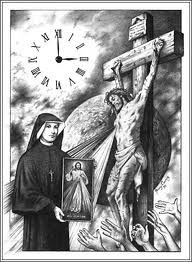
SPREAD OF THE DEVOTION: Jesus told St. Faustina that this Feast of Mercy would be a very special day when “all the divine floodgates through which graces flow are opened” (Diary 699). Even before her death in 1938, the devotion to The Divine Mercy had began to spread. The message of mercy is that God loves us no matter how great our sins. He wants us to call upon Him with trust, receive His mercy, and let it flow through us to others. The message is nothing new, but it is a reminder of what the Church has always taught through Scripture and Tradition: that God is merciful and forgiving and that we, too, must show mercy and forgiveness. But in the Divine Mercy Devotion, the message takes on a powerful new focus, calling people to a deeper understanding that God’s love is unlimited and available to everyone—especially the greatest of sinners. Thus, all will come to share His joy.
LIVING THE MESSAGE OF DIVINE MERCY: The Divine Mercy message is one we can call to mind simply by remembering A.B.C.:
A — Ask for His Mercy. God wants us to approach Him in prayer constantly, repenting of our sins and asking Him to pour His mercy out upon us and upon the whole world.
B — Be merciful. God wants us to receive His mercy and let it flow through us to others. He wants us to extend love and forgiveness to others just as He does to us.
C — Completely trust in Jesus. God wants us to know that the graces of His mercy are dependent upon our trust. The more we trust in Jesus, the more we will receive.
When we look at the image of the Merciful Savior, or pause for prayer at three o'clock, or pray the Chaplet, are we drawing closer to the real sacramental life of the Church and allowing Jesus to transform our hearts? Or have they just become religious habits? In our daily lives are we growing more and more as people of mercy? Or are we just giving "lip service" to God's mercy? The devotional practices revealed through St. Faustina were given to us as "vessels of mercy" through which God's love can be poured out upon the world, but they are not sufficient unto themselves. It's not enough for us to hang The Divine Mercy image in our homes, pray the Chaplet every day at three o'clock, and receive Holy Communion on the first Sunday after Easter. We also have to show mercy to our neighbors. Putting mercy into action is not an option of the Divine Mercy Devotion; it's a requirement!
Our Lord strongly speaks about this to St. Faustina: 'I demand from you deeds of mercy which are to arise out of love for me. You are to show mercy to your neighbors always and everywhere. You must not shrink from this or try to excuse yourself from it" (Diary, 742).
Like the Gospel command, "Be merciful, just as your Father is merciful," this demand that we show mercy to our neighbors "always and everywhere" seems impossible to fulfill. But the Lord assures us that it is possible. "When a soul approaches Me with trust," He explains, "I fill it with such an abundance of graces that it cannot contain them within itself, but radiates them to other souls" (Diary, 1074).
How do we "radiate" God's mercy to others? By our actions, our words, and our prayers. "In these three degrees," Jesus tells Sister Faustina, "is contained the fullness of mercy" (Diary 742). We have all been called to this threefold practice of mercy, but we are not all called in the same way. We need to ask the Lord, who understands our individual personalities and situations, to help us recognize the various ways we can each show His mercy in our daily lives. By asking for the Lord's mercy, trusting in His mercy, and sincerely trying to live His mercy in our lives, we can be assured that we will never hear Him say of us, "Their hearts are far from Me," but rather that wonderful promise, "Blessed are the merciful, for they shall obtain mercy."
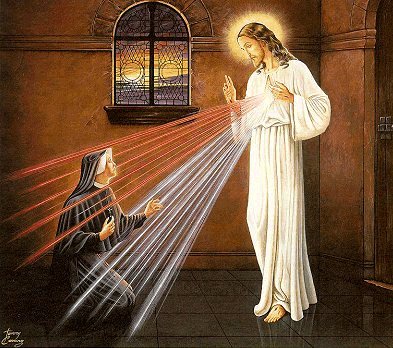
THEOLOGY OF THE FEAST OF THE DIVINE MERCY
The establishment of the Feast of The Divine Mercy on the octave day of Easter fulfilled the purpose of the restoration of the liturgical year, allowing "the faithful through their faith, hope and love to share more deeply in the whole mystery of Christ as it unfolds throughout the year" (Moto Proprio of Pope Paul VI, 1969, on the Liturgical Year and Roman Calendar, quoting Vatican II on the Liturgy, 102). It ensures even greater prominence to the Paschal Mystery of Christ, so that the faithful more effectively "lays hold of the mysteries of Christ and are filled with His saving grace" (Ibid).
How does it achieve these purposes? In a number of ways: The Feast of Mercy has its roots deeply planted in the Old and New Testament and in the early Church Tradition. It is a feast with three distinct dimensions, each emphasizing an aspect of the Paschal Mystery that needs to be brought out more clearly and appropriated by the faithful: merciful love, atonement, and covenant.
The Feast of Mercy is a Celebration and a Summation of God's Merciful Love
The Triduum of Holy Week, along with the entire Easter season, focuses on various aspects of the Paschal Mystery. Holy Thursday celebrates the Mass of the Chrism and the evening Mass of the Mandatum--the washing of the feet of the disciples, ordination to the priesthood, the institution of the Eucharist, and the last discourse of Our Lord promising the sending of the Holy Spirit. Good Friday commemorates the Passion and Death, and celebrates the fulfillment of the prophecies of the Redeemer who is our light and salvation, bringing us new life by water and the Holy Spirit. The Easter season continues this celebration, leading to the Ascension of the Lord and to Pentecost--the fulfillment of the promise to send the Holy Spirit.
The Feast of Mercy focuses on God's mercy as an event! It focuses on God's continuing action of mercy throughout salvation history as we see it recorded in the letter to the Romans (Chapters 9, 10, 11), culminating in His loving plan to have mercy on all! (Rom 11:32.) This Feast is a summation of the event to His mercy active in our lives now. It is because of His mercy that we have forgiveness of sin and new life as children of God. This needs to be celebrated!
The Feast of Mercy is a Day of Atonement
The Feast of Mercy is the fulfillment of the Old Testament Day of Atonement (Lev. 16, Lev. 23:26-32 and Sir. 50). It is a day of forgiveness of sins for those who approach the Eucharist and the Sacrament of Reconciliation. It is an annual celebration like the Day of Atonement--all sins and punishment are washed away in His infinite mercy. The focus of this Paschal event is on God's mercy for us sinners and His free gift to those who turn to Him with trust.
Interestingly enough, the texts of the liturgy for that Sunday (Second Sunday of Easter) already focus on the forgiveness of sins and mercy. The Gospel is of Jesus appearing in the upper room and bestowing the authority to forgive sins (Jn 20:19-5), and the other readings are about the Blood and Water and the proclamation of mercy (there was no need to change the texts for Divine Mercy Sunday!).
Our Easter liturgy had fulfilled the major feasts of the Old Testament--Passover and Pentecost--and was missing only the Day of Atonement. This Feast of Mercy now completes the needed fulfillment of Old Testament feasts.
The Feast of Mercy is the Covenant of Mercy
The Octave day has its roots in the Old Testament and New Testament as the Day of Covenant. On the eighth day after His birth, a male child was circumcised as a sign of the covenant and given His name (Gen. 17:12-14; Lk. 2:21). In the early Church the newly baptized, newly born in Christ, wore white robes until the Sunday in White (Dominica in Albis), the Octave day of Easter, symbolizing their innocence. The Feast of Mercy once again celebrates the white innocence we receive by the Covenant of Mercy.
St. Augustine calls these days "days of mercy and pardon" (No. 156, Dominica in Albis) and the Sunday "the compendium of the days of mercy." And then, referring to the setting aside of the white robes, he warns, "Let not our interior purity be lessened as we set aside its exterior symbols." (No.156, Dominica in Albis).
Like the covenant of Sinai we, too, prepare for the Feast by purification from our sins and by the sprinkling of blood and proclaiming of the law (Ex 19:14-15; Ex 24:6-8), but this time we are cleansed by the Precious Blood of the Lord and the Proclamation of His mercy. On the Octave day of Easter we, too, ratify the Covenant of Mercy, reaffirming not only our Baptism, already renewed at the Easter vigil, but also the Sacraments of Reconciliation, Confirmation and Eucharist. Interestingly enough, all the elements of creation are structured in units of eight (as seen in the periodic table), and musical chords resonate with the octave.
The Feast of Mercy is the Octave day of the Resurrection, which strikes the resonant chord of Easter, developing the meaning and richness of the Paschal Mystery and applying it in a new and deeper way. It resonates with all of nature, sounding anew the grace of the resurrection, alleluia!
The Feast of Mercy: The Desire of the Lord
As we have seen, the reasons for establishing the Feast of Mercy are strong and clear in themselves. The Feast is rooted in the Old Testament, and an earlier form of the Feast was celebrated from the fourth century as Dominica in Albis. But, in our times, there is an additional reason that makes the need for the Feast of Mercy even more urgent, and that strengthens the meaning and effectiveness of such a feast for the faithful. In His revelations to St. Faustina, Our Lord specifically and repeatedly asked that the Feast of Mercy be established on the Octave day of Easter.
One day, as St. Faustina was offering all her prayers and sufferings so that this feast would be established, she said to Jesus: "They tell me that there is already such a feast and so why should I talk about it?" Jesus answered: "And who knows anything about this feast? No one! Even those who should be proclaiming My mercy and teaching people about it often do not know about it themselves. That is why I want the image to be solemnly blessed on the First Sunday after Easter, and I want it to be venerated publicly so that every soul may know about it." (Diary 341)
The idea of this special celebration of God's mercy on the Sunday after Easter is not a new or radical idea stemming simply from private revelation. Our Lord, through St. Faustina, is simply reemphasizing what was strongly urged by St. Thomas the Apostle in the earliest liturgical document in existence, the "Apostolic Constitutions." There we read: "After eight days (following the feast of Easter) let there be another feast observed with honor, the eighth day itself on which He gave me, Thomas, who was hard of belief, full assurance, by showing me the print of the nails, and the wound made in His side by the spear."
This feast had been celebrated in the early Church.
One of the greatest Doctors of the Church, St. Gregory of Nazianzen, also supports this Feast, declaring that the Octave day of Easter is an even greater Feast than Easter, though it takes nothing whatever away from the greatness of the Day of the Resurrection itself. Easter Sunday is the boundary between death and life (a creation). But its eighth day, the Octave, is the fulfillment of what Easter is all about--perfect life in eternity (a second creation, more admirable and more sublime than the first).
Easter Sunday represents our creation in the life of Grace through faith in the Risen Savior. The Octave Sunday of Easter represents the fulfillment of that "creation in grace." Thus it is, as St. Augustine says, "The most privileged Octave-day" and certainly merits the title "Feast of The Divine Mercy."
The "most privileged Octave-day" did not even appear under that title in the revised Roman Missal. It was called that only in the "Ordo"--the book that regulates the celebration of the liturgy. Our Lord surely knew what He was saying to St. Faustina: "And who knows anything about this feast? No one! Even those who should he proclaiming My mercy and teaching people about it often do not know about it themselves" (Diary 341).
We now have the key to understanding the Image of The Divine Mercy with its rays signifying the Blood and Water that flowed from Christ's pierced side with the inscription, "Jesus, I Trust In You," and to Our Lord's insistence that this image be specially venerated on the first Sunday after Easter, which is to be celebrated as the FEAST OF MERCY (Divine Mercy Sunday).
We can also see these rays as simultaneously symbolizing the Holy Spirit, whom Christ breathed into the Disciples during the same Octave-day appearance. On the strength of that Holy Breath, all sins are forgiven and "at-ONE-ment" with the Father is accomplished. Here, God in Christ is reconciling the world to Himself (2 Cor 5:18). And here the Church, the newly-born Body of Christ, is commissioned to be the instrument of reconciliation down through the ages.
This is Christ's GREAT PROMISE of complete pardon of sin and punishment on the Feast of Mercy through the reception of the Sacraments (which is a participation of Christ's death to sin and rising to divine life). All the elements of the message and devotion to The Divine Mercy focus on the Feast of Mercy.
The day of the Feast is celebrated by using the normal liturgy for that day (Second Sunday of Easter), as per the Decree dated May 5, 2000, for Divine Mercy Sunday, which are all focused on mercy, and a homily on God's mercy. Our Lord asked for a Feast of His Mercy to bring attention to the outpouring of the ocean of graces, and to His promise of the complete forgiveness of sins and punishment to the souls that will go to Confession and receive Holy Communion.
The desired fulfillment: a deeper sharing
Those who have been celebrating the Octave of Easter in this way, as the Feast of Mercy, have experienced the desired effect of the Second Vatican Council for the liturgical year renewal--a deeper share in the mystery of Christ.
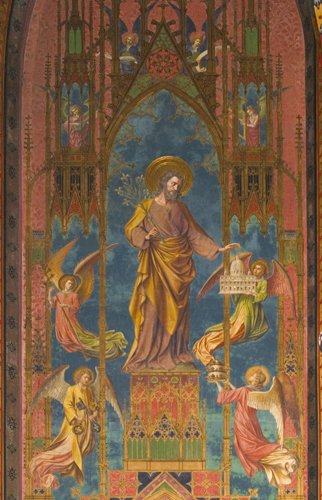
St. Joseph, Protector of the Church
The St. Joseph Prayer Group meets in the church on Wednesdays at 6:15 p.m. in front of the St. Joseph statue. This is a group for those who have a special devotion to St. Joseph, the husband of the Blessed Virgin and the Foster Father of Jesus. They were formed to pray for Peace and Justice throughout the world. Everyone is free to join the group at any time to participate in the prayers. If you have any questions, please call the Coordinator, Lucy Marikian, at (626) 281-3706.
St. Teresa of Avila, a Discalced Carmelite nun and mystic, took St. Joseph as her spiritual patron after his intercession cured her when she was young. Click on "Devotion to St. Joseph" (in the dark red column to the left) for an article entitled, "Go to Joseph," for information about devotion to St. Joseph.
The following quotes, taken from her autobiography, concern her devotion to St. Joseph:
"I took for my advocate and lord the glorious Saint Joseph and commended myself earnestly to him; and I found that he delivered me both from this trouble [a temporary paralysis] and also from other and greater troubles concerning my honor and the loss of my soul, and that he gave me greater blessings than I could ask of him. I do not remember even now that I have ever asked anything of him which he has failed to grant. I am astonished at the great favors which God has bestowed on me through this blessed saint, and at the perils from which He has freed me, both in body and in soul. I wish I could persuade everyone to be devoted to this glorious saint, for I have great experience of the blessings which he can obtain from God. I have never known anyone to be truly devoted to him and render him particular services who did not notably advance in virtue, for he gives very real help to souls who commend themselves to him. For some years now, I think, I have made some request of him every year on his festival and I have always had it granted. If my petition is in any way ill directed, he directs it aright for my greater good. If anyone cannot find a master to teach him how to pray, let him take this glorious saint as his master and he will not go astray."
The following article gives us more insight into St. Joseph:
ST. JOSEPH, SPOUSE OF THE BLESSED VIRGIN,
VIRGINAL FATHER OF JESUS
AND PATRON OF THE UNIVERSAL CHURCH
St.
Joseph was by birth of the royal family of David, but was living in
humble obscuritiy as a carpenter, until God raised him to the highest
office ever accorded a moral man, by choosing him to be the spouse of
the Virgin Mother, the virginal father and guardiain of the Incarnate
Word. Joseph, says Holy Scripture, was a just man. He was innocent and
pure, as became the husband of Mary; he was gentle and tender, as one
worthy to be named the father of Jesus: he was prudent and a lover of
silence, as became the master of the holy house. Above all, he was
faithful and obedient to divine calls.
His conversation was with
Angels rather than with men. When he learned that Mary bore within Her
womb the Lord of heaven, he feared to take Her as his wife; but an Angel
bade him put his fear aside, and all doubts vanished. When Herod sought
the life of the divine Infant, an Angel told Joseph in a dream to fly
with the Child and His Mother into Egypt. Joseph at once arose and
obeyed. This sudden and unexpected flight must have exposed both him and
his little Family to many inconveniences and sufferings; the journey
with a newborn infant and a tender virgin was long, and the greater part
of the way led through deserts and among strangers. Yet St. Joseph
alleges no excuses, nor inquires at what time they were to return.
St.
Chrysostom observes that God treats in this way all His servants,
sending them frequent trials to clear their hearts from the rust of
self-love, but intermixing with afflictions, seasons of consolation. It
is the opinion of the Fathers that when the Holy Family entered Egypt,
at the presence of the Child Jesus all the oracles of that superstitious
country were struck dumb, and the statues of their gods trembled, and
in many places fell to the ground. The Fathers also attribute to this
holy visit the spiritual benediction poured on that country, which made
it for many ages fruitful in Saints.
After the death of King
Herod, of which St. Joseph was informed in another vision, God ordered
him to return with the Child and His Mother into the land of Israel,
which he readily accomplished. But when he arrived in Judea, hearing
that Archelaus had succeeded Herod in that part of the land, and
apprehensive that the son might be infected with his father’s vices, he
feared to settle there, as he would otherwise probably have done, for
the education of the Child. Therefore, directed by God through still
another angelic visit, he retired into the dominions of Herod Antipas in
Galilee, and to his former habitation in Nazareth.
St. Joseph, a
strict observer of the Mosaic law, journeyed each year at the time of
the Passover to Jerusalem. Our Savior, in the twelfth year of His age,
accompanied His parents. Having participated in the usual ceremonies of
the feast, the parents were returning with many of their neighbors and
acquaintances towards Galilee, and never doubted that Jesus was with
some of the company. They traveled on for a whole day’s journey before
they discovered that He was not with them. But when night came on and
they could find no trace of Him among their kindred and acquaintances,
they, in the deepest affliction, returned with the utmost haste to
Jerusalem. We are left to imagine their tears and their efforts to find
Him. After an anxious search of three days they discovered Him in the
Temple, discoursing with the learned doctors of the law, and asking them
such questions as aroused the admiration of all who heard Him. His
Mother told Him with what grief and earnestness they had sought Him and
asked, “Son, why have You dealt with us in this way? Behold, Your Father
and I have searched for You in great affliction of mind.” The young
Savior answered, “How is it that You sought Me? Did You not know that I
must be about My Father’s business?” In this way Jesus encourages all
young persons who are called to serve God to persevere in that high
vocation, whatever the cost. But we are told that although He had
remained in the Temple unknown to His parents, in all other things He
was obedient to them, returning with them to Nazareth, and living there
in all dutiful subjection to them.
As no further mention is made
of St. Joseph, he must have died before the marriage feast of Cana and
the beginning of our divine Savior’s ministry. We cannot doubt that he
had the happiness of the presence of Jesus and Mary at his death,
praying beside him, assisting and comforting him in his last moments;
therefore he is invoked for the great grace of a happy death and the
spiritual presence of Jesus in that hour.
GO TO JOSEPH!
When the people of ancient Egypt were undergoing a famine, they cried out to Pharaoh for food. He responded, “Go to Joseph and do whatever he tells you to do” (Genesis 41:55). With today’s world in such turmoil, we again need to "go to Joseph," but now this means praying to the husband of the Blessed Mother and the earthly father of Jesus.
St. Teresa of Avila, the foundress of the Discalced Carmelite order, is largely responsible for the popularity of devotion to St. Joseph. In the sixth chapter of her autobiography, she writes: “I took for my advocate the glorious St. Joseph and commended myself earnestly to him. I do not remember ever asking him for anything which he failed to grant. Jesus wishes to teach us that just as He was subject to St. Joseph on earth, in Heaven Our Lord still does all that he asks of Him. I only beg that anyone who does not believe me will put what I say to the test, and he will see by experience what great advantages come from commending himself to this glorious patriarch.”
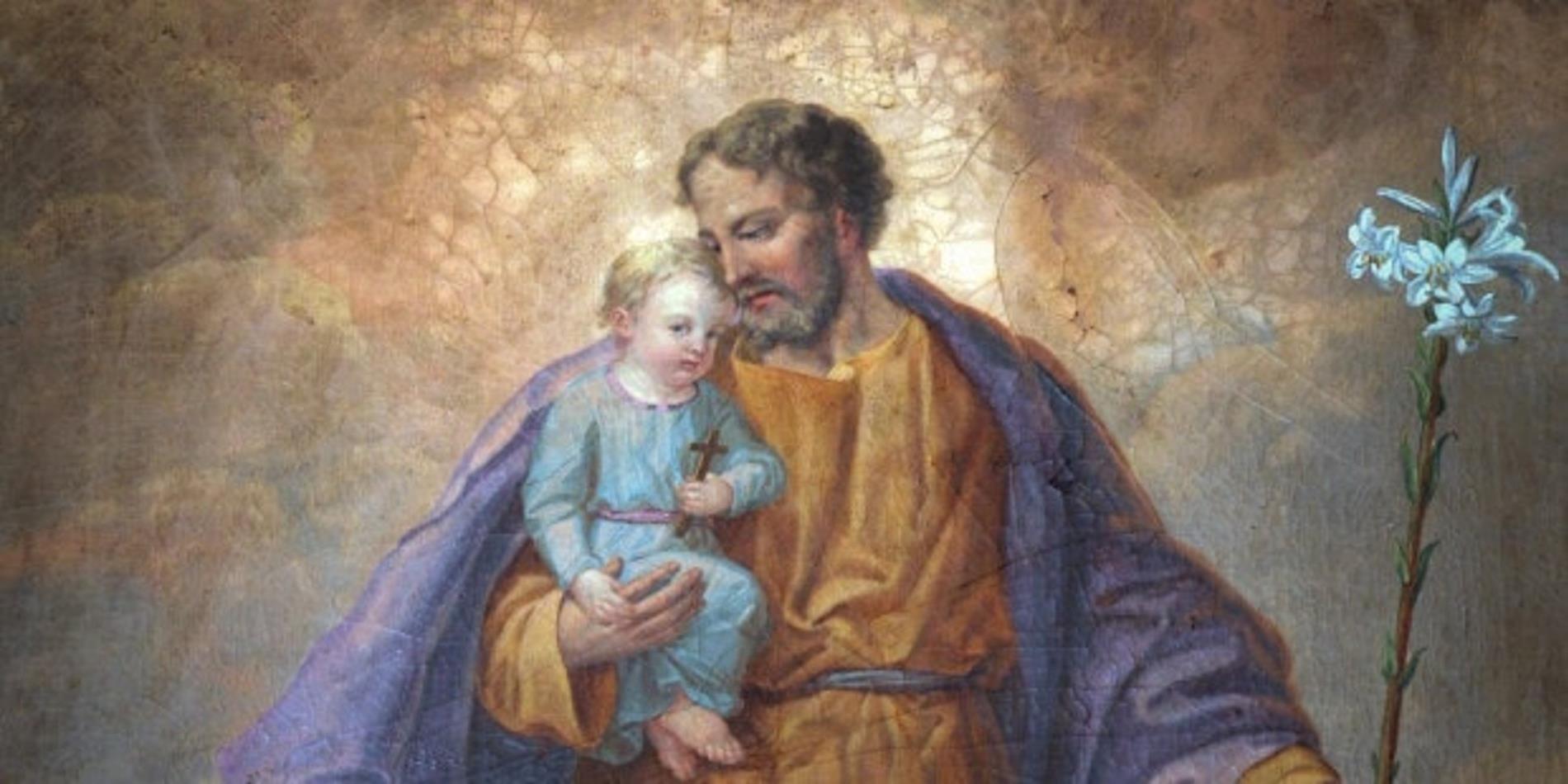
When St. Teresa desired to establish a monastery, she got direct orders from Our Lord to dedicate her first reformed [Discalced] Carmel to St. Joseph. In fact, she ended up dedicating two-thirds of her monasteries to him. She is the promoter of unlimited trust and confidence in St. Joseph! When it comes to St. Joseph, St. Teresa—a Doctor of the Church—has the right “prescription.”
Many of our Popes have praised this "Just Man" of the New Testament. Blessed Pius IX declared him the "Patron of the Universal Church," which is a title above and beyond that given to any other saint in history, except for the Blessed Virgin Mary. Leo XIII confirmed of St. Joseph that "there is no doubt he approaches nearer than any other to that superabundant dignity of Our Blessed Mother Mary." Pius XI spoke of his "all-powerful intercession" as the true head of the Holy Family.
Since his election in 2013, Pope Francis has wasted no time in giving historic honor to St. Joseph. In one of his first acts as Holy Father, he decreed that the name of St. Joseph was to be inserted after the reference to the Virgin Mary into all four of the main Eucharistic prayers. Pope Francis' strong personal love for St. Joseph is likewise indicated by the saint's presence on his papal coat of arms in the form of a vine.
However, it was another Pope, St. John XXIII, who, on November 13, 1962—during the first session of Vatican II—had St. Joseph’s name added to the Roman Canon of the Mass for the first time (for at least 150 years before that, bishops had been petitioning Rome to have this done). St. John even declared St. Joseph to be the Patron of the Second Vatican Council. Yet another Pope, St. John Paul II, wrote in Redemptoris Custos (Guardian of the Redeemer): “Patronage to St. Joseph must be invoked, not only as a defense against all dangers, but also as an impetus for renewed commitment to evangelization. Because St. Joseph is the protector of the Church, he is also the guardian of the Eucharist and the Christian family. We must plead with St. Joseph to guard our Eucharistic Lord and the Christian family during this time of peril.”
If you don’t normally pray to Joseph, Lent is a great time to begin. Suggested devotions include praying the Joyful mysteries of the Rosary (St. Joseph was present at all five), and meditating on his Seven Sorrows and Seven Joys (shown below). Traditionally, this devotion consists of reciting the "Our Father" and the "Hail Mary" seven times each during your meditation (one Our Father and One Hail Mary per each set of sorrows and joys).
1st Sorrow – Joseph Resolves to Leave Mary (Matthew 1:18-19)
1st Joy – The Annunciation to St. Joseph (Matthew 1:20-21)
2nd Sorrow – The Poverty of Jesus’ Birth (Luke 2:6-7)
2nd Joy – The Birth of the Savior of Mankind (Luke 2:10-19)
3rd Sorrow – The Circumcision of Christ (Luke 2:21)
3rd Joy – The Holy Name of Jesus (Matthew 1:24-25)
4th Sorrow – Simeon’s Prophecy (Luke 2:34-35)
4th Joy – The Salvation of Mankind (Luke 2:29-33)
5th Sorrow – The Flight into Egypt (Matthew 2:13-14)
5th Joy – The Toppling of the Idols (Isaiah 19:1)
6th Sorrow – The Perilous Return from Exile (Matthew 2:19-22)
6th Joy – Family Life at Nazareth (Luke 2:39-40)
7th Sorrow – The Loss of Jesus in Jerusalem (Luke 2:42-45)
7th Joy – The Finding of Jesus in the Temple (Luke 2:46-52)
In the spirit of St. Teresa of Avila, please pray the following Novena to St. Joseph for your own intentions, for the protection of the Carmelite family, for the success of Saint Therese Carmelite School, and for continued blessings upon St. Therese Church and all its parishioners and visitors.
NOVENA TO ST. JOSEPH (To be prayed from March 11 to 19)
O glorious St. Joseph, to you do we raise our hearts and hands to implore your powerful intercession in obtaining from the benign Heart of Jesus all the helps and graces necessary for our spiritual and temporal welfare, particularly the grace of a happy death and the special favor we now seek. O Guardian of the Word Incarnate, we have confidence that your prayers on our behalf will be graciously heard before the throne of God. O Glorious St. Joseph, through your love for Jesus Christ and for the glory of His Name, hear our prayers and obtain our petitions. Amen.
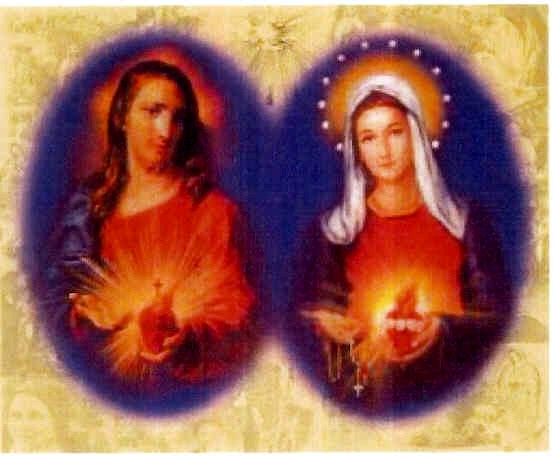
“To those devoted to My Sacred Heart, I will be their refuge in life and especially in death.” (Jesus to St. Margaret Mary Alacoque)
This all-night vigil is held every first Friday and First Saturday of each month in St. Therese Church. It begins with Holy Mass at 7:30 p.m. on Friday evening and concludes with Benediction at 5:45 a.m., followed by the 6:00 a.m. Mass on First Saturday morning.
One of the Carmelite Fathers celebrates the Mass and gives the conference at 9:00 p.m. The Alliance of the Two Hearts conducts the prayers which are held throughout the night. Light refreshments are available outside the church during the breaks.
Remaining dates for 2013 are: May 3/4, June 7/8, July 4/5, August 2/3, September 6/7, October 4/5, November 1/2, and December 6/7.
The full schedule is as follows:
7:30 p.m. Holy Mass for First Friday
8:30 p.m. Exposition/Adoration
9:00 p.m. Conference/Talk
10:00 p.m. Break
10:30 p.m. Nine Offices of the Alliance of Two Hearts
1:00 a.m. Break
1:30 a.m. Office of the Immaculate Heart
2:00 a.m. Silent Meditation
3:00 a.m. Divine Mercy Chaplet
4:00 a.m. Prayers for Priests/Vocations
5:45 a.m. Benediction
6:00 a.m. Holy Mass for First Saturday

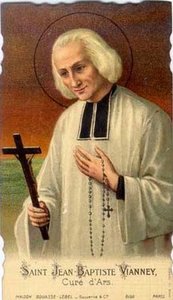
"The Priesthood is the heart of the love of Christ." --St. John Vianney (the Curé of Ars)
The prayer group, Prayer Intercessors for Priests (also known as the "Prayer Warriors") is an intercessory prayer ministry which prays for priests--especially our Carmelite Friars--and all souls entrusted to them. They also pray for Our Holy Father, and for all Bishops. Of course, prayers are also said for the needs of our own Church community, and the ministries and families of St. Therese Parish.
The group was formed as a result of the declaration of Pope Benedict XVI that the year beginning on June 19, 2009, would be THE YEAR OF THE PRIEST. The year was dedicated to prayer for the sanctification and renewal of the clergy. Using the words and witness of the saintly Curé of Ars, St. John Mary Vianney, as a backdrop for his letter to his beloved priests, Pope Benedict broke open the depth and beauty of the priestly vocation. He also invited all of the faithful to fully participate in praying for priests.
The Prayer Intercessors for Priests meet in the church every Thursday evening at 8:00 p.m. You are very welcome to join! The only requirement is a loving heart. For more information, you may contact the coordinator, Blanca Ruvalcaba.
ST. THÉRÉSE ON PRAYING FOR PRIESTS:
Thérèse spent a month on pilgrimage before visiting Rome to see the Holy Father. Also on the pilgrimage were many priests, who unfortunately taught her that priests can be weak and feeble men deeply in need of prayer. She wrote later: "I met many saintly priests that month, but I also found that in spite of being above angels by their supreme dignity, they were nonetheless men and still subject to human weakness. If the holy priests, 'the salt of the earth,' as Jesus calls them in the Gospel, have to be prayed for, what about the lukewarm? Again, as Jesus says, 'If the salt shall lose its flavor, with what shall it be salted?' I understood my vocation in Italy."
At fourteen, Thérèse had understood her vocation to pray for priests to be "an apostle to apostles." In September 1890, at her canonical examination before she professed her religious vows, she was asked why she had come to Carmel. She answered "I came to save souls, and especially to pray for priests." Throughout her life she prayed fervently for priests, and she corresponded with and prayed for a young priest, Adolphe Roulland, and a young seminarian, Maurice Bellière. She wrote to her sister, "Our mission as Carmelites is to form evangelical workers who will save thousands of souls, whose mothers we shall be."
PRAYERS / MEDITATIONS
M O T H E R O F G O D: Mary is Mother of the Church, Mother of the Apostles, Mother of the Redeemer (of OUR Redeemer), Mother of the Clergy and of every consecrated soul. Mother and Queen of Heaven and Earth—yet she is more Mother than queen; because she is also a refuge of sinners and our Advocate, our Intercessor before the Throne of God, before the Most Precious and Holy Heart of her Son Jesus. Let us come to her, trusting in her motherly love, to grant us what we need most: a clean and pure heart, so she can bring the Most Holy and Beloved Son to abide in us, to be born in our hearts. May it be so for the Glory of God and for the salvation of our souls “Asi sea.” Amen.
I HAVE A DREAM that you and I will sing in praise and adoration and will also intercede for our priests and for our needs as One Body and One Heart, without regard to size, shape, color or cultural background. All that is needed is your desire to intercede from the heart. Then, with one heart and one voice, we will elevate our offering of love to God for one and all. Let us make this dream a glorious reality!
ONE LORD, ONE GOD OF ALL, is our Triune God: Listen to Him, follow Him. Do as He tells you. He and only He has the words of eternal life. Never do your own will!; God has the “owner’s manual”! He created you and knows you better than you know yourself. HE LOVES YOU more than you love yourself. So, in doing His will and not your own, you will be loving yourself and following the path to eternal life with God, our Father, our Creator, and the One Lord of all.
“HOLY MARY, MOTHER OF GOD, Virgin Immaculate, you appeared eighteen times to Bernadette at the grotto in Lourdes to remind Christians of what the truths in the Gospel require of them. You call them to prayer, penance, the Eucharist, and the life of the Church. To answer your call more fully, I dedicate myself, through you, to your Son Jesus. By the fervor of my faith, by the conduct of my life in all its aspects, by my devotion to praying for your priests, let me work with you in the reconciliation of people, that the Church may be one and that there may be peace in the world. All this I ask, confident that you, Our Lady, will fully answer my prayer. Blessed be the Holy and Immaculate Conception of the Blessed Virgin Mary, Mother of God. Our Lady of Lourdes, pray for us. St. Bernadette, pray for us."
"HAIL, FAVORED ONE, the Lord is with you! Hail Mary, Ave Maria, the “Full of Grace,” the Blessed of Blesseds, the Mother of God, and OUR MOTHER, the Queen of Heaven and Earth, the Queen and Mother of the clergy, the Queen and Mother of us ALL. ~ My dear brothers and sisters: Listen to her and let us DO AS HE TELLS us; so you and I, as well, can each be called “the favored one with the Lord.”
"HEAVENLY FATHER, may the torrents of love flowing from the sacred wounds of Thy Divine Son bring forth priests like unto the beloved disciple John who stood at the foot of the Cross; priests who, as a pledge of Thine own most tender love, will lovingly give Thy Divine Son to the souls of men. May Thy priests be faithful guardians of Thy Church, as John was of Mary, whom he received into his house. Give us priests who are on fire, and who are true children of Mary, priests who will give Jesus to souls with the same tenderness and care with which Mary carried the Little Child of Bethlehem. Mother of sorrows and of love, out of compassion for Thy beloved Son, open in our hearts deep wells of love, so that we may console Him and give Him a generation of priests formed in thy school and having all the tender thoughtfulness of thine own spotless love.’"
“WE LOVE OUR ENEMIES, and we pray for those who persecute us.” —Archbishop José H. Gomez ~ This is what we are called to emulate from a real priest, a real Archbishop, a real leader, a real spiritual Father, Alter Christus. Let us pray for our Archbishop, and for all our beloved priests who are the channels of the grace of God, the only path that can make this possible for you and for me.
“NO! NO! DON'T KILL ME--not because I don’t want to die, but because I don’t want you to die!” ~ This is the message that St. Maria Goretti (1890-1902) wanted her killer to understand. However, he was blinded by the evil one and could not see that in killing her body, he was killing his very own self. He did stab her to death. Yet this precious soul would not give up in trying to convert him. What she couldn’t do during her earthly life, she did from heaven! Through her intercession, let us pray for our beloved priests, that they may be instruments of conversion for hardened souls.
"TEACH US TO PRAY," the disciples said to Jesus. (Luke 11:1). He answered by teaching them the prayer we call the Our Father or The Lord's Prayer. The Lord's Prayer is a basic Christian prayer learned by every Christian. It appears everywhere in the Church's life: in its liturgy and sacraments, in public and private prayer. Through this prayer, Jesus invites us to approach God as Father. Indeed, the Lord's Prayer has been called a Summary of the Gospel. When we pray His prayer, His spirit becomes our own.
LISTEN TO HIM who has the words of eternal life. Listen to Him who is the Way. Listen to Him who has the Truth—who IS the Truth. Listen to Him who gave you Life and who wants you to live it abundantly. To live it here, but also, more importantly, IN ETERNITY! Pray or become prey! Pray to do His will and not your will—and receive the guarantee of a lifetime—for then you will have life here AND in ETERNITY with Him forever and ever without end!
MARY, THE GATE OF HEAVEN, ...was lifted up to reside next to the King of Glory, who first ascended and prepared a place for her, His Blessed Mother. Exalted above all the heavens, she is the most glorious and radiant splendor of all the celestial court. May her holy and maternal intercession prepare for us a place next to the Eternal High Priest, along with all her children, her most beloved and cherished priests.
QUEEN OF HEAVEN, The Son whom you were privileged to bear has risen as He said. Alleluia! Pray to God for us! Rejoice and be glad, Virgin Mary, for the Lord has truly risen, Alleluia.
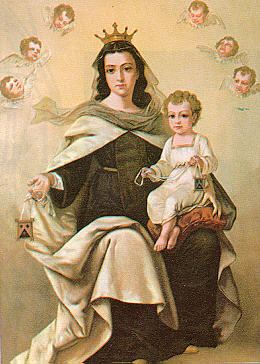
“With zeal have I been zealous for the Lord God of hosts.”
The Secular Order of Discalced Carmelites welcomes those of the lay faithful who, by special vocation, undertake to live, in the world, an evangelical life of fraternal communion with the Discalced Carmelite priests and nuns, imbued with the spirit of contemplative prayer and apostolic zeal, according to the example and teaching of the Carmelite saints.
Secular Carmelites come from all walks of life, men and women, young and old, married and single—each one trying to respond to God's call to "meditate on the Lord's law, day and night". As Secular Carmelites, we try to show God's love in our everyday lives, wherever God leads us and with the people God gives us. The Secular Carmelite Constitutions are used to help us transform into the people that God intended us to be. According to the Secular Carmelite Constitutions, a Secular Carmelite endeavors:
1. To devote a minimum of a half-hour each day to mental prayer or dedication.
2. To recite Morning and Evening Prayers from the Liturgy of the Hours, and, if possible, Night Prayer before retiring.
3. To wear the Brown Scapular of Our Lady of Mt. Carmel as a sign of one's devotion to Mary and membership in her Order.
4. To attend daily Mass if possible.
5. To honor Mary by some particular act of devotion (the Rosary is highly recommended).
6. To have an esteem for the Sacrament of Reconciliation and receive the Sacrament frequently.
7. To have an active apostolate.
8.
To observe the feasts of the Order and fast on the Vigil of the
following feasts: Our Lady of Mt. Carmel (July 16), The Prophet Elijah
(July 20), St. Therese of Lisieux (October 1), Our Holy Mother St Teresa
of Jesus (October 15), All Saints of the Carmelite Order (November 14),
and Our Holy Father St. John of the Cross (December 14). Abstinence on
these Vigils is not obligatory.
For more information, please contact the Alhambra-area President, Stan Interrante, at (714) 996-4164 or the Membership Coordinator, Roseanna Valencia, at (323) 257-1360 or sannval@aol.com.
“Prayer is nothing else than an intimate sharing between friends; it means taking time frequently to be alone with Him who we know loves us.” --St. Teresa of Avila